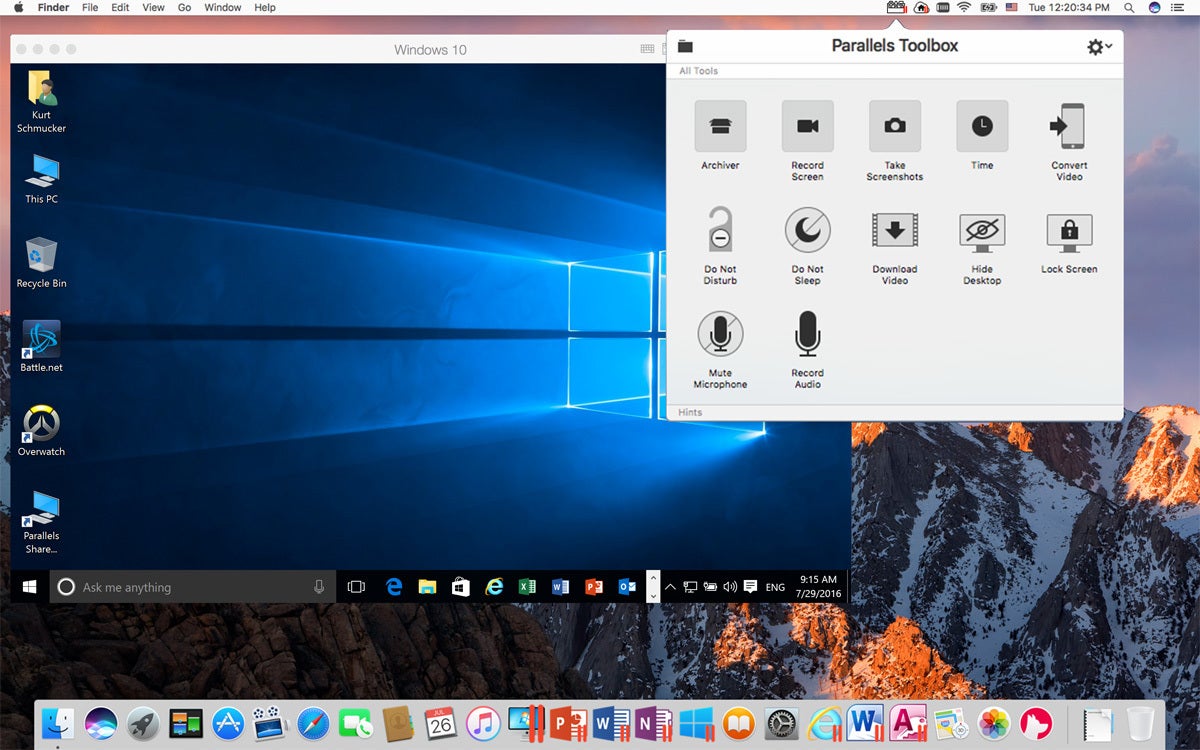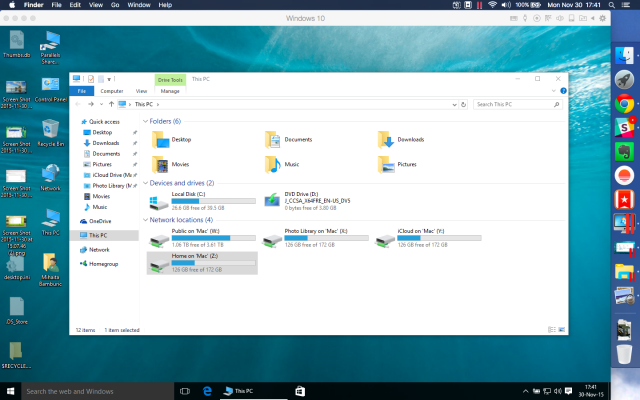- Windows Creators Or Windows Anniversary For Parallels Mac Review
- Windows Creators Or Windows Anniversary For Parallels Mac Management
- Windows Creators Or Windows Anniversary For Parallels Mac
Also make sure that you are running the latest update of Parallels Desktop for Mac. NOTE: Windows 10 free upgrade policy from Microsoft ended on July, 29. You may purchase a Windows 10 license from Microsoft at.
- “For a new installation of Windows 10 Creators Update on an Apple Mac using Boot Camp, you must first install the Windows 10 Anniversary Update using the ISO file, and then update to Windows 10 Creators Update.
- Parallels Toolbox for Mac and Windows 30+ tools in a lightweight, powerful, all-in-one application for Mac ® and PC. Easy to use and economical—a whole suite of tools for a fraction of the cost of individual apps, packaged in one simple interface.
The latest version of macOS Sierra brings support for Windows 10 Creators Update, finally allowing Apple users to install the most recent Windows 10 release with Boot Camp on their devices. This category of software includes utilities such as the excellent Parallels Desktop for Mac. You run Windows on top of the macOS platform, so you can have Mac and Windows running side-by-side.
If you're a Mac user that also runs Windows 7 or Windows 8.1 on your desktop or laptop, and you've not yet grabbed your free upgrade to Windows 10, then time is running out for you.

The deadline for the free Windows 10 upgrade offer is July 29, so if you want the upgrade, you need to be quick about it. After that date, the price is going to increase to at least $119.
Windows 10
If you've been actively using your Windows installation on your Mac, and you've been keeping up with the updates, then chances are high that you've been reminded, then reminded again, then pestered, cajoled, and then hassled to upgrade already. In fact, if you've come this far and not yet upgraded, then I congratulate you on your grit and determination.
If you've not yet pulled the trigger on the Windows 10 upgrade, here are a few things to bear in mind.
First things first. To qualify for the free upgrade you need to be running a genuine, activated copy of one of the following Windows editions:
- Windows 7 - Starter/Home Basic/Home Premium/Professional/Ultimate
- Windows 8.1 - Standard/Pro/Pro for Students
Now, if you're running Windows through Apple's Boot Camp program then you need to make sure that your Mac can run Windows 10. According to Apple, you need a 64-bit Mac running OS X Yosemite or later. Apple has put together a list of compatible hardware here.
Before upgrading the Windows installation, I recommend that you download and install all Mac updates before carrying out the Windows upgrade.
Now you should be ready to upgrade Windows. As long as you have a good amount of free space -- 25 gigabytes or so -- you should be good to go.
If, after upgrading to Windows 10 in Boot Camp you find that some things -- such as the track pad, audio, or such -- aren't working properly, then you might need to update the Windows drivers for Boot Camp.
See also: Trackpad++: Must-have Mac productivity-boosting utility for Boot Camp users
But Boot Camp isn't the only way to run Windows on a Mac. Another way is to run it inside a virtual machine using a virtualization software tool such as Parallels Desktop (which is my preferred method of running Windows on a Mac).
Unlike Boot Camp, Parallels Desktop isn't free software, but it does offer far more in the way of features and functionality. For example, you can run multiple instances of Windows, roll back any changes made to the operating system, and even run other operating systems on your Mac, such as Linux.
But of all the additional features that virtualization software offers, the most useful is that it allows you to run Windows alongside OS X, giving you instant access to all your programs and files without having to boot between OS X and Windows.
If your copy of Windows is running inside virtualization software, then you first need to make sure that your software is up to date and is compatible with Windows 10. For example, only Parallels Desktop 10 or later supports Windows 10, and if you are running an older version then you will need to pay for an upgrade.
After doing that, you're ready to proceed with the Windows 10 upgrade.
The bottom line is whether you are running Windows on your Mac through Boot Camp or virtualization software such as Parallels Desktop, Macs are very capable Windows 10 systems. In fact, Macs make awesome Windows 10 PCs!
So, if you want that free Windows 10 upgrade, you've got a few days left to grab it. As long as you have the compatible hardware and software, there really is no reason to not give Windows 10 a whirl (if you don't like it, you can roll back to your old operating system within the first 30 days).
So, what are you waiting for?
Windows Creators Or Windows Anniversary For Parallels Mac Review
See also:
Related Topics:
Apple Microsoft Enterprise Software Windows PCs Reviews- 8.0Excellent
Pros
- ✓Runs Windows and Linux VMs on Macs
- ✓Improved integration between Mac and Windows apps
- ✓Supports macOS Sierra and Windows 10 Anniversary Update
Cons
- ✕Business and Pro Editions require annual subscription
- ✕Virtual machines require lots of memory and storage
- ✕Poor documentation for first-time users
Parallels Desktop is celebrating its tenth birthday this year, and its regular cycle of annual updates has helped to consolidate its position as the leading virtualization tool for Mac users who need to run Windows apps on their office computers.
Last year's update followed the launch of Windows 10; it was a major upgrade that focused on supporting new Windows technologies, such as the Cortana voice-driven virtual assistant. This year's Parallels Desktop 12 is a more modest update, but it does include a number of useful features that make it a worthwhile upgrade for existing users.

Desktop options
Like its predecessor, Parallels Desktop 12 provides three options for different types of users. The standard Parallels Desktop 12 is designed for home and education use, and allows you to buy a one-off, single-user licence for £64.99 (inc. VAT, or £54.16 ex. VAT), or a two-user licence for £97.49 (inc. VAT, or £81.25 ex. VAT). Existing owners of the standard edition can upgrade to version 12 for £34.99 (inc.VAT, or £29.16 ex. VAT).
There is also a Pro Edition that includes additional features for developers, and a Business Edition that provides extended technical support, as well as tools for IT managers who need to manage multiple virtual machines within their organisation. The Pro and Business Editions both require an annual subscription of £79.99 (inc. VAT, or £66.66 ex. VAT), which includes automatic upgrades for each new version. However, the core features and improvements in Parallels Desktop 12 are common to all three versions, and even the standard edition will be perfectly adequate for many business users who simply need to run a few Windows apps every now and then.
Parallels performance
Windows Creators Or Windows Anniversary For Parallels Mac Management
Some of the new features in Parallels Desktop 12 are clearly aimed at home users, such as the ability to run the Xbox streaming app for Windows on the Mac. But there are also a number of timesaving improvements that will appeal to business users. Parallels continues to finetune the program's performance, and we found that we were able to suspend or resume a Windows 10 virtual machine on our office iMac in just three seconds -- that's around 50 percent faster than with the previous version.
There's a new Always Ready mode that automatically launches a specific virtual machine when you boot the Mac, but leaves it paused in the background so that it's instantly available as soon as you need to open a Windows app. Your Windows apps can also be assigned a series of 'behaviors', such as always opening in full-screen mode, or automatically hiding the Windows desktop and other apps.